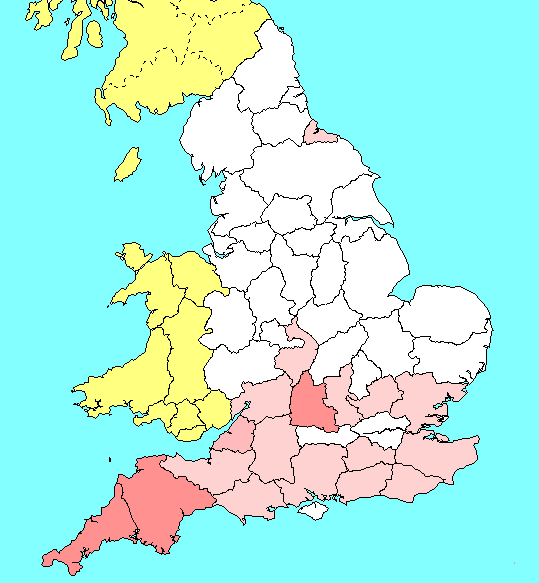1999 Population
A count of the occurences of the surname and variants was obtained using the Electoral Rolls and telephone directories for England and Wales (for 1999).
The count is recorded against the modern counties, established in 1974 and modified in 1997/8,
and presented in the table below.
| Glanvil* 1 |
Glenvil* |
County |
Granvil* |
Grenvil* |
| 91 |
1 |
Avon |
20 |
1 |
| 22 |
|
Bedford |
3 |
|
| 28 |
|
Berkshire |
6 |
8 |
| 26 |
|
Buckingham |
12 |
31 |
| 6 |
|
Cambridge |
12 |
2 |
| 6 |
1 |
Cheshire |
8 |
1 |
| 17 |
1 |
Cleveland |
27 |
|
| 114 |
4 |
Cornwall |
20 |
2 |
| 11 |
|
Cumbria |
9 |
|
| 14 |
|
Derby |
6 |
2 |
| 312 |
|
Devon |
43 |
1 |
| 32 |
1 |
Dorset |
3 |
7 |
| 3 |
1 |
Durham |
|
|
| 101 |
2 |
Essex |
18 |
10 |
| 27 |
2 |
East Sussex |
24 |
19 |
| 15 |
3 |
Gloucestershire |
11 |
4 |
| 125 |
2 |
Hampshire |
26 |
15 |
| 1 |
|
Herefordshire |
|
|
| 39 |
4 |
Hertfordshire |
12 |
4 |
| 1 |
|
Isle of Wight |
|
|
| 117 |
9 |
Kent |
39 |
8 |
| 5 |
|
Lancashire |
3 |
|
| 11 |
9 |
Leicester |
4 |
2 |
| 5 |
4 |
Lincolnshire |
|
|
| 97 |
5 |
London |
70 |
13 |
| 7 |
|
Manchester |
6 |
|
| 35 |
5 |
Merseyside |
12 |
6 |
| 32 |
2 |
Middlesex |
10 |
2 |
| 16 |
|
Norfolk |
12 |
5 |
| 8 |
16 |
North Humberside |
|
|
| 21 |
|
North Yorkshire |
2 |
1 |
| 13 |
1 |
Northampton |
3 |
2 |
| 1 |
|
Northumberland |
1 |
1 |
| 21 |
3 |
Nottingham |
8 |
5 |
| 27 |
1 |
Oxford |
21 |
5 |
| 13 |
|
Shropshire |
|
4 |
| 31 |
|
Somerset |
26 |
11 |
| 1 |
|
South Humberside |
|
|
| 25 |
3 |
South Yorkshire |
7 |
|
| 8 |
2 |
Stafford |
4 |
|
| 5 |
|
Suffolk |
11 |
6 |
| 95 |
3 |
Surrey |
33 |
14 |
| 16 |
3 |
Tyne & Wear |
4 |
1 |
| 10 |
3 |
Warwick |
12 |
4 |
| 30 |
7 |
West Midlands |
9 |
2 |
| 33 |
2 |
West Sussex |
15 |
5 |
| 12 |
4 |
West Yorkshire |
9 |
|
| 26 |
|
Wiltshire |
10 |
|
| 14 |
|
Worcester |
4 |
|
| 2 |
|
Clwyd |
2 |
|
| 31 |
|
Dyfed |
5 |
|
| 2 |
|
Gwent |
17 |
|
| 3 |
|
Gwynedd |
|
1 |
| 14 |
|
Mid Glamorgan |
24 |
|
| 12 |
|
South Glamorgan |
10 |
3 |
| 1 |
|
West Glamorgan |
3 |
1 |
| 1795 |
104 |
TOTALS |
645 |
181 |
1 Glanvil* denotes Glanvil, Glanvill, Glanvile, Glanville and other endings.
Analysis on 1999 Population
Performing a similar analysis to 1881 reveals the county Glanville (including all variants)
populations as a percentage of the total Glanville population.
Additionally, using 1997 population figures allows a count of Glanville's per 100,000 head
of population.
Wales
5% of the current England and Wales Glanville population are Welsh. These people are
included in the population totals for the purpose of county analysis, but the current lack of county
demographics for the whole population in The Principality precludes a per 100k head of population
analysis for the time being.
It should be obvious that some counties cannot be compared to 1881 as the county boundaries have
been altered through the 1974 and 1997/8 changes. Devon and Cornwall are not affected by these, but
Greater London affects Surrey, Kent, Essex and Middlesex; Greater Manchester affects Lancashire as
does Merseyside.
| County |
County Population
as percent of Whole |
Head Count 1
per 100,000 Population |
| Avon |
4 |
12 |
| Bedfordshire |
1 |
5 |
| Berkshire |
2 |
5 |
| Buckinghamshire |
2 |
6 |
| Cambridgeshire |
1 |
3 |
| Cheshire |
1 |
2 |
| Cleveland |
2 |
8 |
| Cornwall |
5 |
29 |
| Cumbria |
1 |
4 |
| Derbyshire |
1 |
2 |
| Devon |
13 |
33 |
| Dorset |
2 |
6 |
| Durham |
|
1 |
| East Sussex |
3 |
10 |
| Essex |
5 |
8 |
| Gloucestershire |
1 |
6 |
| Hampshire |
6 |
10 |
| Hereford. & Worcestershire |
1 |
3 |
| Hertfordshire |
2 |
6 |
| Humberside |
1 |
3 |
| Isle of Wight |
|
1 |
| Kent |
6 |
11 |
| Lancashire |
|
1 |
| Leicester |
1 |
3 |
| Lincolnshire |
|
1 |
| London (Greater) |
7 |
3 |
| Manchester (Greater) |
|
1 |
| Merseyside |
2 |
3 |
| Norfolk |
1 |
4 |
| North Yorkshire |
1 |
3 |
| Northamptonshire |
1 |
3 |
| Northumberland |
|
1 |
| Nottingham |
1 |
4 |
| Oxfordshire |
2 |
9 |
| Shropshire |
1 |
4 |
| Somerset |
2 |
14 |
| South Yorkshire |
1 |
3 |
| Staffordshire |
1 |
1 |
| Suffolk |
1 |
3 |
| Surrey |
5 |
14 |
| Tyne & Wear |
1 |
2 |
| Warwickshire |
1 |
6 |
| West Midlands |
2 |
2 |
| West Sussex |
2 |
7 |
| West Yorkshire |
1 |
1 |
| Wiltshire |
1 |
6 |
1 The Electoral Roll / Telephone Directory approach is known to undercount for a number of reasons:-
- Ex-Directory People
People who are ex-directory are omitted, but were counted if they were on the Electoral Roll
- Poll Tax Evaders
A number of people avoid completing the return to be entered on the Electoral Roll, attempting to avoid
liability for the Poll Tax - a hangover from the unpopular tax of the early 1990s. One person per household
would be counted though, if they had phones and were not ex-directory.
- Minors
The Electoral Rolls do not list individuals under age, and hence not eligible to vote. An estimate of
their number can be produced using figures supplied by the
Office of National Statistics who quote
that in 1984 to 1997 the percentage of the population aged between 16 and retirement age was 61 to 61.4 percent.
A further 17.9 to 18.1 percent were aged over retirement, and hence the Glanville's counted must be the
sum of these (around 81.5 percent), assuming the distribution of Glanville's follow the national age
distribution.
This estimate could be double-checked (again using the Office of National Statistics information) from the
fact that in 1996 the average household size was 2.4 (this figure having dropped from 2.59 in 1984).
Taking the grand total of names (including variants) of 2,725 and multiplying up to include the
Minors on the basis that the counted people account for 81 percent of the total, yields a total of 3,364 individuals.
The current (1997) population of England and Wales is 52.2 million - up from 25.9 million in 1881.
Therefore, one would expect a steady Glanville population in the whole population to have risen from the
1881 census total of 2,095 individuals to a current figure of 4,230 individuals. The shortfall of 4,230 - 3,364 = 866
(20 percent of the expected population) might be accounted for by the undercounting identified above, or might be a reflection of a decline in
the surname.
3,364 individuals in 52.2 million means one person in 15,517 is surnamed by a variant of the name Glanville,
and one person in 23,556 is surnamed GLANVILLE or GLANVILL.
1999 Population Density of Glanvilles
|
The distribution of the surname, including variant spellings from the 1999 Electoral Rolls
and Telephone Directories census is shown on the map.
The deeper colour density represents a higher population of Glanvilles per 100,000 head of population,
and the light colours represent a lower population density within the base population.
| White Counties | have
under 5 Glanvilles per 100,000 head of population |
| Yellow Counties | are not analysed |
It should not be assumed that the Glanville population was evenly distributed within each county.
In those counties containing major centres of population such as Plymouth in Devon the population
is focussed in those centres.
|
 |
1999 Whole Population
From the Office of National Statistics . . .
The mid-2002 population of the constituent countries of the United Kingdom is estimated as follows:
- England 49,561,800 (83.7 per cent of the total UK population)
- Scotland 5,054,800 (8.5 per cent)
- Wales 2,918,700 (4.9 per cent)
- Northern Ireland 1,696,600 (2.9 per cent)
Between 1981 to 1991 (ten year period) there was an increase of 1.1 million people
in the United Kingdom, compared with an increase of 1.8 million people between
1991 to 2002 (eleven year period). During the period 1981 to 2002 the average
annual increase in population for the United Kingdom was 136,900 people.
From this, you can estimate the 1999 population of England, Wales and Scotland was 57,125,800.


